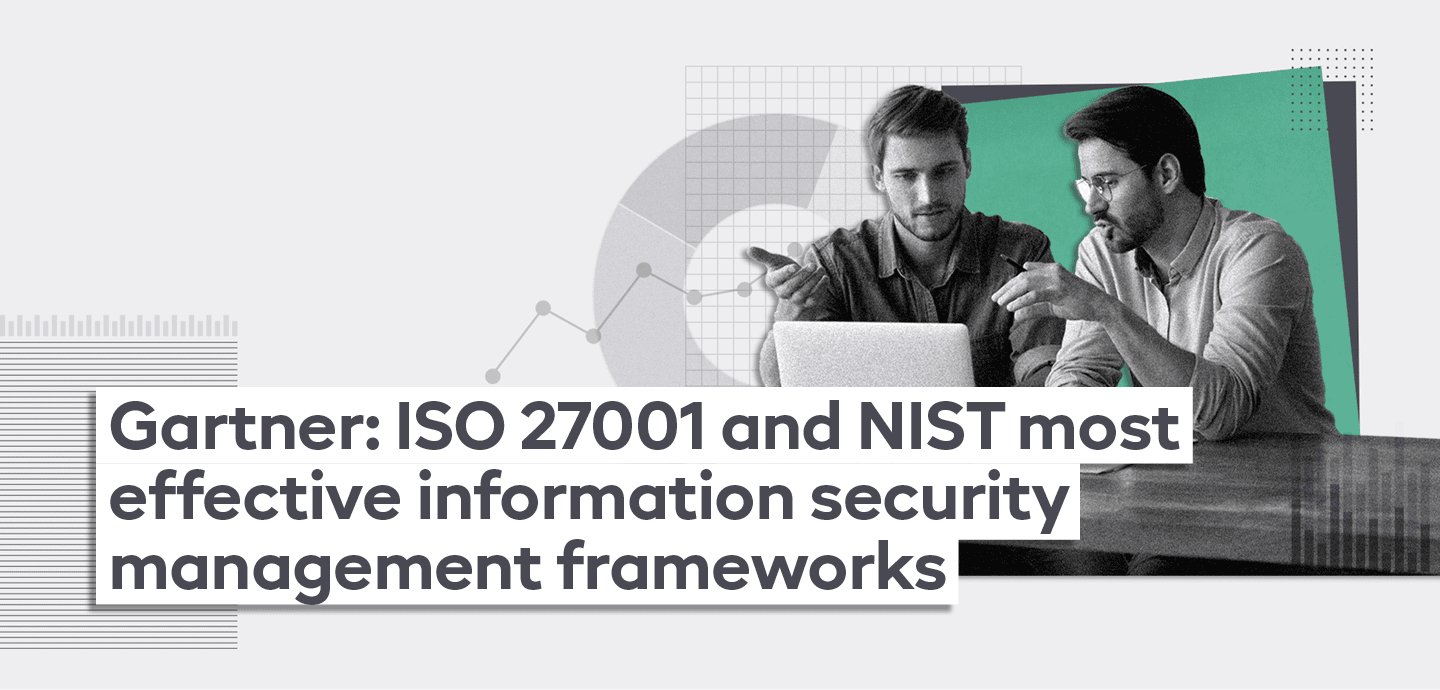
Gartner: ISO 27001 and NIST Most Effective Information Security Risk Management Frameworks
Table Of Contents:
- 1) What Are Security Frameworks, Control Catalogues and Security Processes
- 2) Why Do Organisations Need Security Frameworks
- 3) Why Do ISO 27001 and NIST Make The Most Effective Security Frameworks
- 4) The Business Benefits of ISO 27001 and NIST
- 5) Information Security Frameworks – The Future
- 6) Strengthen Your Information Security and Risk Management Today With an ISO 27001 or NIST-based ISMS
Security and risk management leaders are faced with an array of information security frameworks, control catalogues and processes, all intended to inform the design of their security programs. So, how do organisations select the best framework for their business needs?
Gartner’s recent Technical Professional Advice: Security Frameworks report does just that. It reviewed multiple security framework approaches and concluded that ISO 27001 and NIST (National Institute of Standards and Technology) offer the best structure to empower organisations to achieve information security and risk management success regardless of size, industry vertical, information security, and risk management experience.
What Are Security Frameworks, Control Catalogues and Security Processes
While they are interrelated, security frameworks, control catalogues and security processes perform different roles for a security and risk program.
Security frameworks describe “what” an organisation will do to manage security risks. Working within a security framework empowers organisations to develop robust and defensible approaches to security and instil confidence, both internally and externally, that they’re aligning with industry best practices.
Control catalogues describe “how” the organisation will implement its control environment to protect critical assets. A pre-defined set of responses, the control catalogue is designed to protect an organisation’s information confidentiality, integrity, and availability and meet a set of defined security requirements.
Security processes are the actions, either mandatory or discretionary, that an organisation will take based on the information security policy framework. Each security process comprises a series of interdependent, linked actions designed to achieve a specific security task or outcome.
Why Do Organisations Need Security Frameworks
Security frameworks provide a solid basis for building a coherent security capability within an organisation. Selecting the appropriate framework, controls catalogue and security process for an organisation is also essential to avoid wasted security investment and security team burnout.
Gartner’s research identified that approximately 41% of clients still needed to select a framework or had developed their own ad hoc framework. Failure to choose any framework or build one from scratch can lead to security programs that:
- Have critical control gaps and therefore don’t address current and emerging cyber risks in line with stakeholder expectations.
- Place an undue burden on technical and security teams.
- Waste precious funding on security controls that don’t move the needle on the organisation’s risk profile.
Ultimately, security frameworks provide a valuable bootstrap approach for organisations without a security architecture function. Those organisations with a security architecture function also benefit from using frameworks as it speeds up the ability to achieve a robust security posture by identifying the necessary controls to deliver on business needs.
Why Do ISO 27001 and NIST Make The Most Effective Security Frameworks
ISO 27001 and NIST offer a broad and formal security governance approach to managing security rather than “just” a list of controls. Gartner’s research suggests that any successful security strategy necessitates a security framework of this type to achieve effective governance, measurement and continual improvement of the security controls implementation.
What both ISO 27001 and NIST do is demand that companies have rigour in governance and process to make sure that:
- They select the proper controls for their cyber security risk requirements.
- They manage the controls framework effectively and continuously.
- They maintain evidence that they do so.
- They deliver effective organisational security
At their core, both NIST and ISO 27001 have the same purpose: to protect an organisation’s data and cybersecurity. You are ensuring the security of an organisation and the clients, customers, and partners they do business with.
The Business Benefits of ISO 27001 and NIST
Protection Against The Evolving Cyber-Threat Landscape
Cyber attacks are increasing globally and can significantly impact an organisation and its reputation. An ISO 27001-certified or NIST framework-based information security management system (ISMS) helps protect an organisation and keep it out of the headlines by ensuring it has the tools to strengthen it across the three pillars of cybersecurity: people, processes and technology.
As cyber criminals evolve, so must businesses if they are to remain secure. The frameworks enable organisations to reduce their risk and exposure to security threats by identifying the relevant policies they need to document, the technologies to protect themselves and the staff training to avoid mistakes. They also mandate that organisations conduct annual risk assessments, which helps them stay ahead of the ever-changing risk landscape.
Build Customer Trust & Competitive Advantage
Working within established frameworks such as ISO 27001 or NIST, organisations can demonstrate to stakeholders that they take information security seriously.
Demonstrating a commitment to security standards on a continuous development basis can set organisations apart from competitors, win new business opportunities and enhance their reputation with existing clients and customers. Some organisations will only work with companies that can demonstrate they have certified to ISO 27001 or work within the NIST framework.
Establish Compliance With Regulations
Some organisations working in regulated industries or doing business with certain countries require them to demonstrate compliance with specific regulatory standards.
Frameworks such as ISO 27001 and NIST help organisations avoid the costly penalties associated with non-compliance with data protection requirements such as the GDPR (General Data Protection Regulation) and other industry-specific compliance requirements such as HIPAA, PCI DSS, TISAX®, SOC2 and more. By requiring that each company clearly document all relevant legislative, regulatory and contractual requirements and explicitly outline the organisation’s approach to meet these requirements for each information system.
Information Security Frameworks – The Future
Through 2024, Gartner determines that ISO 27001 and NIST Cybersecurity Framework will remain the predominant enterprise security frameworks complemented by localised and industry-specific standards and regulations.
Business success is now so intrinsically linked to information security success that any organisation looking to futureproof itself can use these frameworks to establish exceptional cyber security standards and create a secure and sustainable platform for growth.
Strengthen Your Information Security and Risk Management Today With an ISO 27001 or NIST-based ISMS
If you’re looking to start your journey to better information and cyber security, we can help.
Our ISMS solution enables a simple, secure and sustainable approach to information management with ISO 27001, NIST and other frameworks. Realise your competitive advantage today.
Resources
- Security Program Management 101 – How to Select Your Security Frameworks, Controls and Processes- Gartner
- Security Frameworks: The What and Why, and How to Select Yours- Gartner




